“So What is French Food?” Benoit and Gaby Offer a Delicious Answer to That Question in New York City
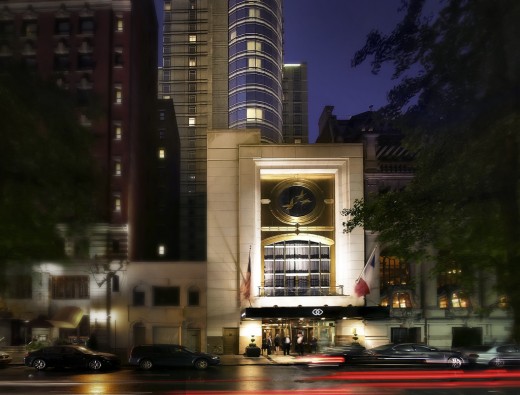
The Sofitel, New York City
“So what is French food?” she asked me. I very much doubt that she’ll ever read these words, but before all else, I want to thank Betty Russo for both her question and her kindness.
Several months later, I still cringe when I remember the way our conversation began. On a warm Spring night, a New Haven bound Metro North train jolted when the transformers were turned on, and then gently rocked its way out of New York City’s Grand Central Station and under Park Avenue to come above ground a few minutes later just before a stop at 125th Street. On my way to speak about my books HUNGRY FOR PARIS and HUNGRY FOR FRANCE at the public library in Westport, Connecticut, my hometown, that night, I was roiled by various emotions. Earlier in the day, it had first dawned on me that this event would be about much more than a just little speech about a pair of books I’d written and my life in Paris to a group of politely interested people. My mother would be in the audience, along with other family members and many other people who’ve known me since I was a little boy. Having chosen to live abroad for most of my adult life, I’d realized that my speech in Westport, a place I’ve always had mixed feelings about–it’s beautiful, smart and morally self-examining on the one hand and way too grossly privileged on the other, would be about splicing myself together, or reconciling the shy little boy who spent hours reading about faraway places and who yearned to know a larger and more vivid world than the one I inhabited with the adult I have become.
So on the train I was sort of fitfully reading a copy of PARIS MATCH I’d lifted from the airport lounge in Paris a few days earlier, and I was so preoccupied on so many different levels that I was startled when someone, the woman I’d sat down next to but hadn’t really seen, spoke to me.
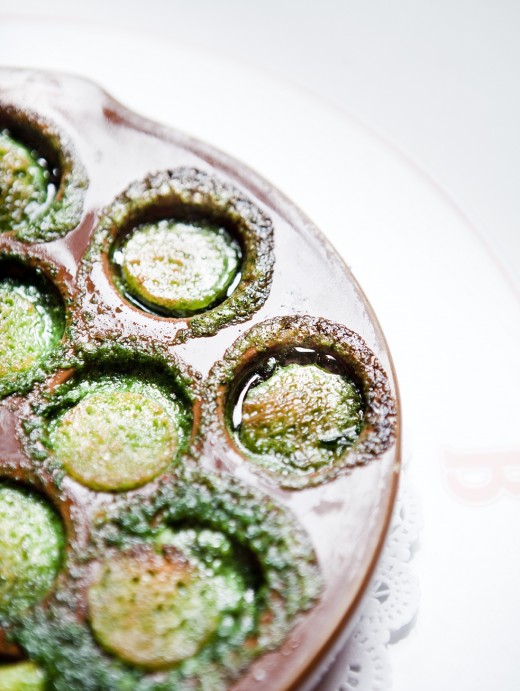
Escargots at Benoit @pierremonetta
“Do you speak French?” she asked, which momentarily exasperated me. Why would I be reading a French magazine if I didn’t know the language? So I nodded, and then registering that she was an older lady, I relented, and I spoke. “I do,” I said and smiled. “And where did you learn that?” she asked. I wasn’t really in the mood to talk, and I’m not generally much of a talker with total strangers in public transport situations under any circumstances, because I like the rare time to myself, but I certainly wasn’t going to be unkind. Maybe I didn’t feel like having a conversation, but maybe someone else really needed one. “Well, I started learning French in school–” I noticed the lady had gentle green eyes “–but I really learned it after I moved to Paris.” “Oh! So do you live in Paris now?” I nodded. “Is that where you bought that magazine?” Another nod. “How lovely that must be, especially now that you know how to speak French.” I nodded, and was still tempted to return to my reading out of some ill-defined fear that this conversation could be depleting me of the fragile social and psychic energies I’d soon be needing in front of the crowd at the public library. Then I noticed that her soft white hands, which she held together loosely in her lap, were lightly trembling. “So are you on your way home then, or is New York home?” I asked. “Oh, New York, I don’t think I could ever do that. It’s very interesting but I love my little garden too much to ever sell my old house in New Haven.” “What do you grow in your garden? “Tomatoes, basil, peppers, eggplant, corn, all kinds of nice things. Right now, though, all I’ve got is just a little bit of lettuce and some radishes.” Her name was Betty Russo, a retired seamstress who used to work in a Gant shirt factory, and she’d gone into New York City for the first time in five years to visit her son, “Tommy,” who’d just had a serious operation in a Manhattan hospital.
So I told her who was I was, too–from Westport, a food and travel writer, living in Europe for a longtime, now returning home to speak at the library. When I finished, she laughed, and patted me on the knee. “So it’s a big day for you then!” she said and chuckled. She really chuckled. I laughed, too, with her and at her, and also with and at myself. Then she said, “You know what? It’s a good thing you’re doing this, and it’s going to be a big success. You just wait!.” I nodded. “Too bad you don’t have time to come to New Haven for a nice pizza, a nice white clam pizza.” I told her I have a permanent yearning for New Haven clam pizza but wouldn’t have the time. We paused, a fleeting but sweet space during which I think we were both trying to think of ways to be kind to each other in the context of a brief encounter. “So Alexander what is French food? I know, it’s fancy and expensive and all that, but I’ve never really understood what it is, like I know that Mexican means tacos, or Japanese means sushi, which I wouldn’t eat if you held a gun to my head, mind you, raw fish, no thank you, but French, well–beyond quiche, I just draw a blank.”
So we chatted about French food, and I wasn’t sure if I was making much sense with my talk about produce and terroir and what have you, and then Betty, ever alert–we’d just stopped in Darien, which meant I’d be leaving the train soon, cut to the chase. “Alexander, can you give me the address of French restaurant or two in New York City? One would be for my grand-daughter who loves good food, so maybe a real French place, not too fancy, but okay, a little expensive if it’s worth it, so I can take her out for graduation from nursing school, and the other would be for my daughter-in-law….” Betty sighed. “You know, well…they’re times when you do your best. She’s a very bright girl, Tommy’s wife, a lawyer! But she has all sorts of what she calls ‘issues’ with food, can’t eat this, can’t eat that. Won’t eat anything from my garden because she says the soil might have heavy metal, whatever the heck that might be.” Betty brushed some imaginary crumbs from the front of her blouse. “I think we may be spending more time together, because of my son’s illness, so think I’d like to take her out to lunch and try and put things off on a better foot between us.”
I might have wept. Instead, I told Betty to take her daughter-in-law to lunch at Gaby’s at the Sofitel New York City on 44th Street between Fifth and Sixth Avenues, an easy walk from Grand Central, which would mean she could arrive without taking a cab, and her granddaughter to Benoit. If you know more about French restaurants in New York, you may be thinking, but what about Daniel or DB Bistro or Batard or Jean-Georges or dozens of other French places in New York? Why these?
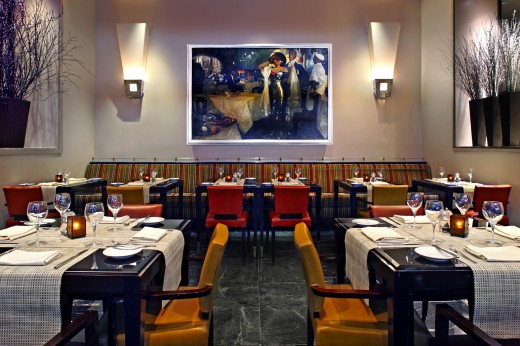
I’d recently discovered Gaby, the restaurant at the Sofitel, sort of by accident. This upmarket French owned and run hotel most recently made notorious due to what did or didn’t transpire in one of its rooms between International Monetary Fund chairman Dominique Strauss Khan and a West African chambermaid has always been a stealth address for me in New York City. By this I mean, they’re times when I arrive in New York City from Paris so bone-deep tired I can barely put one foot in front of another, and then all I want is a really comfortable well-run hotel with reasonable prices in a great location. I don’t want a pillow menu, I don’t want a bath butler, I don’t want all of that. I just want a good well-run hotel with a little style that doesn’t make you wonder if you’re casting yourself correctly. I never stay more than a night or two, because I have friends in New York, but this little sojourn is a gift to myself to get things off to the right foot on a U.S. trip. I’d never really given any thought to the restaurant here–I’ve always gone out–but when I was there in May, the weather was almost tropical the day I got in, the heavens opened as I was walking up Sixth Avenue from Penn Station, and I arrived looking and feeling like a drowned rat. A nice hot shower made me hungry. Still, it was pouring outside, and I was suspended in that strange but not unpleasant place of being both famished and exhausted, so as rain streaked my windows, it occurred to me that I could look up the menu at the hotel’s restaurant online, and low-and-behold, it looked good, really good.
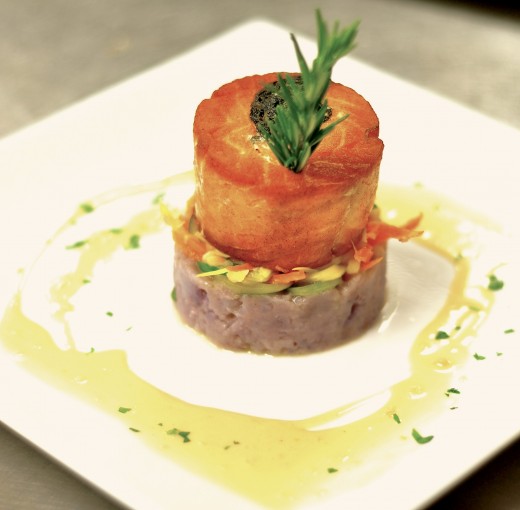
So I went downstairs to Gaby, where a pair of charming French speaking Cambodians couldn’t have possibly made me feel more welcome, and I had a really good meal. First I succumbed to the gimmicky sounding ‘foie gras spring rolls,’ and was surprised they were delicious–gorgeous little spools of foie gras, figs, prosciutto and just enough greenery to make it all seem healthy, and then a beautifully cooked Vancouver Bay salmon filet on a bed of crushed purple potatoes with an impeccably made beurre blanc. This meal really surprised me–it was such an unexpected exemplar of intelligent contemporary French cooking within the confines of a hotel setting–and probably because I was asking the nice older ‘Yugoslav’ waiter so many questions, chef Sylvain Harribey stopped by my table before I went upstairs. A nice guy from Bordeaux, he said he loved cooking in New York, was motivated by Sofitel’s new commitment to healthy dining in its restaurants, and was intensely aware that he was representing France in the world with his efforts. “French food is still often a little misunderstood in the U.S.,” he said. “A lot of people still think of it as rich, fancy and expensive, so so I’m pretty point blank my cooking here. What I do is healthy contemporary French cooking, and it’s all about the produce and all about technique. What’s changed since I’ve lived in the U.S. is that I can now get such fantastic raw materials. In terms of my style, I’m a modern but feet-on-the-ground type of guy. I don’t want to eat flowers–I’m not a goat!–I want a good meal.” I wasn’t in the mood for edible flowers that night either, and what I had was a very good meal from a chef who knows to cater to a sophisticated health-conscious clientele without neglecting the wick of pleasure that lights up any good meal.
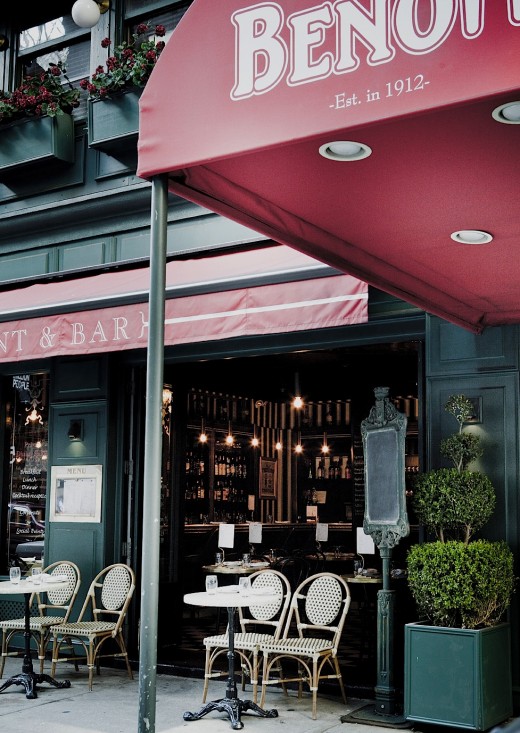
Benoit, NYC @pierremonetta
So in this instance, I was confident Betty could invite her complicated daughter-in-law to lunch here and call her bluff in more ways than one. For the granddaughter, however, I had to do some quick thinking on my feet. In days of yore, there were a dozen or so plain-vanilla French restaurants in the West 50s that were run by the families of mostly Breton cruise-liner crew members who’d decided to stay on make a life for themselves in America. To my knowledge, they’re mostly all gone now, so the type of beautifully prepared classic Gallic menus they offered have become rare.
I haven’t lived in New York City in twenty-five years, but I so wanted to suggest a perfect second address to Betty for her special dinner with her granddaughter, and happily I could, because I’d recently gone to dinner with my old boss, a certain Madame Ruth Reichl, at Benoit, Alain Ducasse’s spin on the Paris original in New York City. I’d been to Benoit once before a very longtime ago, and hadn’t particularly liked it, first of all because the food was so wiltingly removed from the mother ship and also because I just plain didn’t cotton to the idea of trying to merchandise such a profoundly Parisian bistro in a city that had such a different culinary history and produce culture. On this particular evening, the only one Ruth and I could find that cross-hatched, she was just getting out of a book promo event late and wanted somewhere easy and midtown, and since NYC pals had insisted that Benoit has evolved into a really good restaurant , I booked it and hoped for the best.
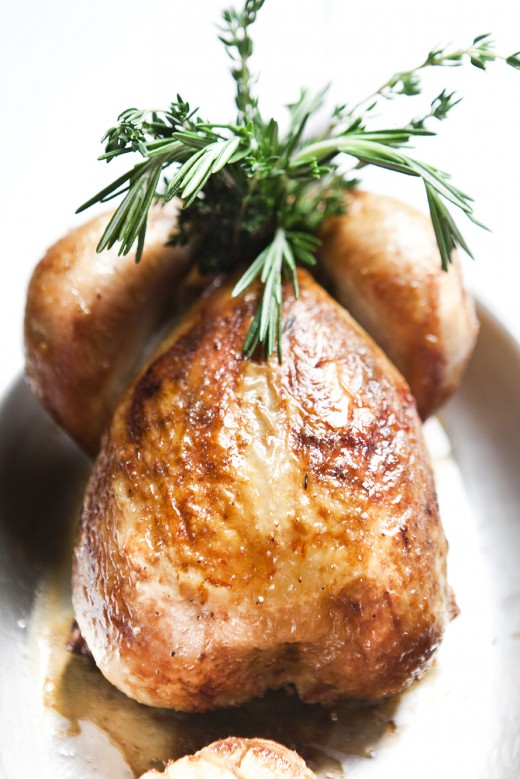
Roast chicken at Benoit @pierremonetta
As it turned out, the best was actually much better than that, too. We had an excellent meal. The almost poignantly talented French chef Philippe Bertineau–I say poignantly, because how many of his foreign and out-of-town clients can really understand just how good he is in the context of being a Frenchman charged with flying the flag of traditional Gallic gastronomic glory in New York City and cooking almost exclusively with North American produce–immediately won us over with some of the best soft-shell crabs I’ve ever eaten.
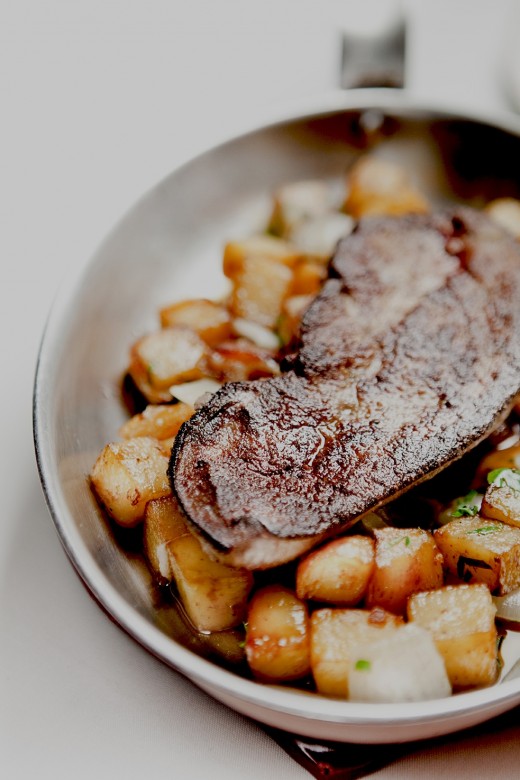
Calf’s liver with potatoes @pierre monetta
I don’t mind admitting that I made a real pig of myself during this meal either, since I evinced an urgent need for tart flambé, the thin-crusted Alsatian tart topped with creme fraiche, bacon and onions, the moment I saw it on the menu, and we also wolfed down one of the best lobster salads I’ve eaten in a longtime. Then Ruth went for the roast chicken, as I rather knew she would, and I decided to see what calf’s liver might be like in the U.S. (When I moved overseas many years ago, I was not yet a calf’s liver eating type of guy, an error that has since been lavishly rectified). Bertineau’s liver–crusted but custard-like inside, with chive-flecked sautéed potatoes, brought on a blanket of homely pleasure and also the exuberance of an expat off-handedly rediscovering the spectacular evolution of the daily quality of American food, even in the context of a classic French dish cooked by a French chef.
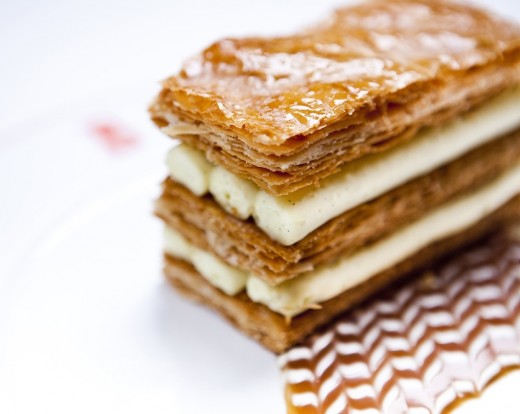
MIllefeuille @pierre monetta
And finally, even though it was late and we were tired, we were having too much fun to shut down our dinner too quickly, and so we shared a gorgeous millefeuille that was sort of a communion-wafer-stand-in for how we became friends and colleagues–we both love great French food. Some other time I’ll blow on the embers of the absolutely catastrophic lunch over which Ruth and I first met each other, but for now, suffice it to say that this meal made it easy for me to tell the lovely Betty that this was where she should take her food-loving granddaughter.
Gaby, Hotel Sofitel New York City, 44 West 45th Street, New York, NY 10036 Tel. (1) 212-782-3040, www.gabynyrestaurant.com Open daily. Average three-course dinner for two without wine $130
Benoit, 60 W 55th St, New York, NY 10019, Tel. (1) 212-646-943-7373, www.benoitny.com Open daily. Average three-course dinner for two without wine $150




